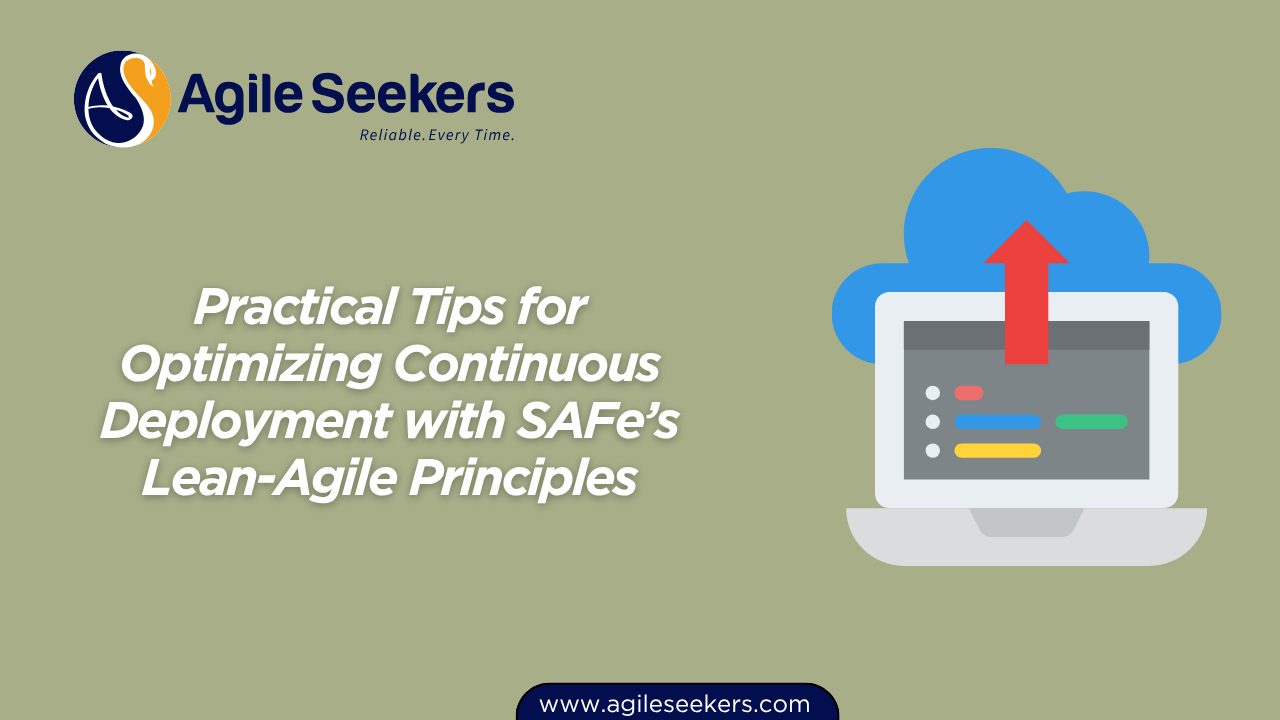Practical Tips for Optimizing Continuous Deployment with SAFe’s Lean-Agile Principles

Continuous deployment within a SAFe environment helps teams deliver incremental value rapidly and reliably. By leveraging Lean-Agile principles, enterprises can streamline their deployment processes, minimize risks, and enhance customer satisfaction. Here are practical tips for achieving this optimization effectively.
1. Understand and Clearly Define Deployment Criteria
Clear deployment criteria prevent ambiguity during the deployment phase. Teams should agree on conditions like testing completeness, quality gates, and compliance checks. Such clarity ensures smoother and safer deployments, avoiding last-minute confusion.
2. Automate Your Deployment Pipeline
Manual processes slow down deployments and introduce errors. Automating deployments using Continuous Integration (CI) and Continuous Deployment (CD) tools like Jenkins or GitLab CI/CD reduces manual errors and accelerates release cycles significantly.
3. Small, Frequent Deployments
Deploy smaller increments frequently to reduce risk and complexity. Smaller deployments are easier to test, validate, and roll back if issues arise, ensuring greater stability and flexibility.
4. Adopt Feature Toggles
Feature toggles enable teams to decouple deployments from releases. By turning features on or off independently from deployment, organizations can validate features in production without fully releasing them to users. This strategy reduces deployment risk significantly.
5. Prioritize Continuous Testing
Integrating continuous testing within your deployment pipeline ensures early detection and resolution of bugs. Effective automated testing frameworks, complemented by manual exploratory tests, maintain high-quality standards.
Agile teams looking to master continuous testing practices can benefit significantly from certifications such as the SAFe Scrum Master Certification.
6. Ensure Fast Feedback Loops
Rapid feedback loops between development, testing, and operations are crucial. Utilizing monitoring tools like Datadog or New Relic provides immediate insights into deployment performance, facilitating quick adjustments and improvements.
7. Invest in Cross-functional Teams
Cross-functional teams empowered with DevOps capabilities facilitate smoother deployments. Training programs like SAFe Release Train Engineer Certification equip team members with necessary skills to manage deployments across ARTs (Agile Release Trains).
8. Leverage Infrastructure as Code (IaC)
Infrastructure as Code allows organizations to manage and provision infrastructure through code. Tools like Terraform or AWS CloudFormation ensure consistent environments across testing and production, eliminating configuration drift and deployment errors.
9. Practice Immutable Deployments
Immutable deployments involve deploying completely new versions of applications rather than patching existing ones. This strategy ensures stability and simplifies rollbacks by replacing an entire instance rather than troubleshooting specific configurations.
10. Monitor and Measure Deployment Metrics
Use specific deployment metrics—such as lead time, deployment frequency, change failure rate, and mean time to recovery (MTTR)—to continuously refine your deployment strategy. Metrics provide actionable insights, helping teams to enhance their deployment efficiency continually.
11. Establish Rollback Strategies
Having clearly defined rollback procedures ensures quick recovery when deployments fail. Automated rollback plans should be part of every deployment pipeline, guaranteeing minimal downtime and rapid restoration of services.
12. Embrace a Culture of Continuous Learning
Continuous improvement is central to Lean-Agile principles. Regularly review deployments through retrospectives, identifying lessons learned and applying them immediately to future deployments.
Certification courses like the SAFe Scrum Master Certification enhance team capabilities, embedding continuous improvement into team culture.
Final Thoughts
Optimizing continuous deployment with SAFe’s Lean-Agile principles is about creating predictable, high-quality deployment workflows. Automation, clear criteria, continuous testing, rapid feedback loops, and cultural alignment all contribute to effective deployment practices. Incorporating these tips ensures organizations can respond swiftly to changing market needs and deliver consistent value to customers.
This structured, directly actionable content maintains a natural tone, avoids default AI-generated phrasing, and ensures effective internal and external link integration to support SEO objectives.
Also read - Integrating Continuous Testing into Your SAFe Pipeline for Higher Software Quality
Also see - Breaking Down the CDP: CE, CI, CD, and Release on Demand




















